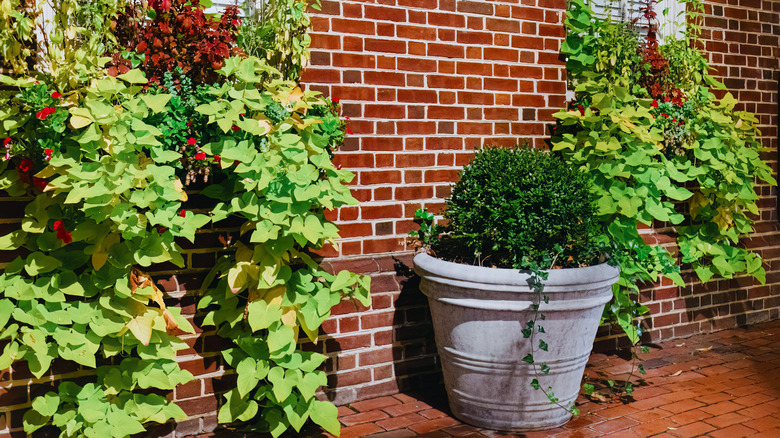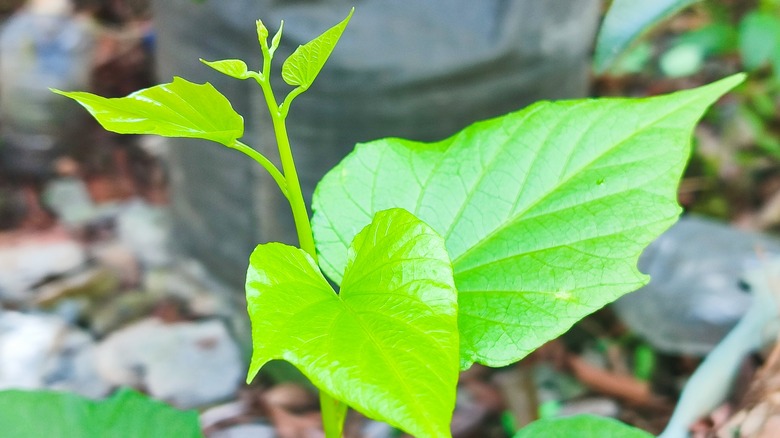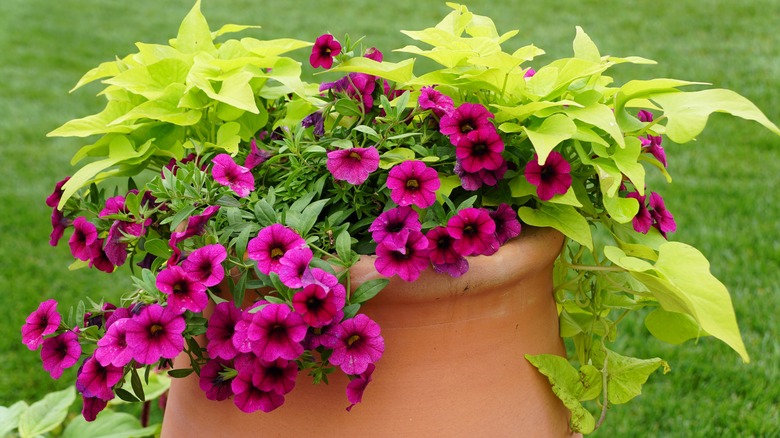The Hearty Vine That Cascades Beautifully In Long Flower Boxes
Vines offer a unique charm to homes and gardens, whether cascading down in a hanging basket, growing up a trellis, or as a beautiful addition to long flower boxes. Not only are they aesthetically pleasing, but they're often low-maintenance and easy to grow for nearly any gardener. Sweet potato vines (Ipomoea batatas) have lush foliage in shades of bright yellowish green, bronze, purple, red, and even black. You can also find eye-catching variegated varieties. Although they belong to the same family as edible sweet potatoes, they're typically only grown ornamentally, as most of the cultivars are either bitter or lack flavor.
Native to Central and South America, Ipomoea batatas is hardy in zones 9 to 11 and thrives in warmer weather. Although it prefers a temperature range of 65 to 95 degrees Fahrenheit, the sweet potato vine can survive through cooler temperatures as long as the soil stays above 55 degrees Fahrenheit. If you're outside of this plant's hardiness zone, you can bring them inside to keep as a houseplant until temperatures rise again in spring. Another option is to take cuttings from your plants and grow them in water to plant once winter ends. It's a tough vining plant that's much easier to care for than your dramatic pothos, so you may enjoy growing some of the vines indoors as houseplants, too. Let's get into everything you need to know about the different sweet potato vine cultivars and how to grow them properly.
Selecting and planting the perfect sweet potato vine
Before planting Ipomoea batatas, it's a good idea to consider all the available options. Once you choose the best flowering plants for your window boxes, adding a more compact sweet potato vine variety, such as the Sweet Caroline Sweetheart Lime hybrid, is better suited than larger types. This variety features chartreuse green, heart-shaped leaves that create an amazing backdrop for flowers like petunias. Another stunning vine to consider is the Sweet Caroline Sweetheart Jet Black, which has nearly true black leaves and similar growth habits and leaf shapes. To add even more color, you can try the Tricolor variety, which has attractive pale green leaves variegated with pink and white.
Plant sweet potato vine when the risk of frost has passed, ideally in a warm and humid area. While most Ipomoea batatas cultivars share similar growth requirements, there can be slight variations depending on the specific variety. Generally, sweet potato vine thrives in moist, slightly acidic, and well-drained soils. Although most can tolerate some shade, they grow best and have the richest color pigments when they receive at least eight hours of sunlight. These thirsty plants require regular watering and don't like having their soil dry out. However, it's crucial to avoid waterlogging them, which can lead to root rot and other fungal diseases. Although spacing can vary depending on the variety, you'll want at least 6 to 12 inches of room around smaller varieties and closer to 2 feet in between larger hybrids.
Care and maintenance tips for thriving sweet potato vines
Once established, as long as your sweet potato vines are receiving the right growth conditions, they're fairly easy to keep happy. That said, for optimal growth, you should apply a well-balanced liquid fertilizer starting in the spring. The general rule of thumb is to feed them monthly, though you should always check the instructions to make sure you're giving your plants the correct dosage. Be careful not to pour fertilizer onto the foliage or stems, as it could cause them to burn. Give the leaves a quick rinse if you do accidentally drop some food onto any part of the plants to protect them from damage.
One of the many benefits of planting this fast-growing vine in your garden is how quickly it adds lush green foliage to containers like long flower boxes. However, their rapid-spreading nature also means they can take up an area quickly. If you're not careful, the vines could take up more space than less-competitive species can handle, so pruning will be your best friend. Use a sharp, sanitized pair of shears or scissors to remove any leggy stems or overgrowth as you see fit. To enjoy more of the foliage, you can use a trellis to give your plants support. The layering effect of the spilling leaves paired with the vertical growth can add even more depth and texture to your display.


